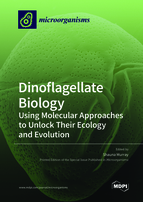Dinoflagellate Biology: Using Molecular Approaches to Unlock Their Ecology and Evolution
A special issue of Microorganisms (ISSN 2076-2607). This special issue belongs to the section "Environmental Microbiology".
Deadline for manuscript submissions: closed (30 April 2022) | Viewed by 23065
Special Issue Editor
Interests: harmful algal blooms; qPCR; phylogenetics; evolution; molecular ecology; benthic dinoflagellates; systematics
Special Issues, Collections and Topics in MDPI journals
Special Issue Information
Dear Colleagues,
Dinoflagellates are an important group of aquatic microbial eukaryotes, showing great diversity in life histories, ecological niches, and morphology and pigment composition. They include species with photosynthetic, heterotrophic, symbiotic, mixotrophic and parasitic lifestyles, and encompass coral symbionts, harmful algal bloom forming species, and important fish parasites. They have a presence in fossil records that date back several hundred million years. Dinoflagellates include the majority of species that produce marine biotoxins, impacting aquaculture. In recent years, molecular approaches have been applied to understand dinoflagellate biology, including techniques for studying dinoflagellate ecology, physiology, basic genetics and evolution. This special issue is dedicated to the application and development of molecular approaches for enhancing our understanding of dinoflagellate biology.
Prof. Dr. Shauna Murray
Guest Editor
Manuscript Submission Information
Manuscripts should be submitted online at www.mdpi.com by registering and logging in to this website. Once you are registered, click here to go to the submission form. Manuscripts can be submitted until the deadline. All submissions that pass pre-check are peer-reviewed. Accepted papers will be published continuously in the journal (as soon as accepted) and will be listed together on the special issue website. Research articles, review articles as well as short communications are invited. For planned papers, a title and short abstract (about 100 words) can be sent to the Editorial Office for announcement on this website.
Submitted manuscripts should not have been published previously, nor be under consideration for publication elsewhere (except conference proceedings papers). All manuscripts are thoroughly refereed through a single-blind peer-review process. A guide for authors and other relevant information for submission of manuscripts is available on the Instructions for Authors page. Microorganisms is an international peer-reviewed open access monthly journal published by MDPI.
Please visit the Instructions for Authors page before submitting a manuscript. The Article Processing Charge (APC) for publication in this open access journal is 2700 CHF (Swiss Francs). Submitted papers should be well formatted and use good English. Authors may use MDPI's English editing service prior to publication or during author revisions.
Keywords
- harmful algal bloom Symbiodinium
- Alexandrium
- protist
- amplicon sequencing
- qPCR
- genomics
- phylogenetics
- molecular ecology
- transcriptomics
- gene expression
- molecular barcoding







